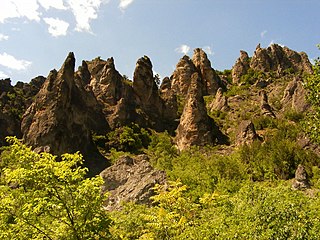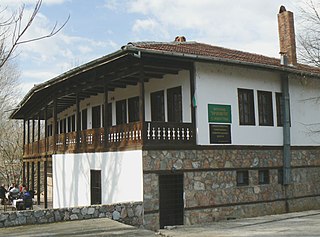
Kyustendil Province is a province in southwestern Bulgaria, extending over an area of 3,084.3 km2 (1,190.9 sq mi), and with a population of 107,673. It borders the provinces of Sofia, Pernik, and Blagoevgrad; to the west, its limits coincide with the state borders between Bulgaria and North Macedonia, and between Bulgaria and the Republic of Serbia. The administrative center of the Province is Kyustendil.

Rila is the highest mountain range of Bulgaria, the Balkan Peninsula, and Southeast Europe. It is situated in southwestern Bulgaria and forms part of the Rila–Rhodope Massif. The highest summit is Musala at an elevation of 2,925 m which makes Rila the sixth highest mountain range in Europe after the Caucasus, the Alps, Sierra Nevada, the Pyrenees and Mount Etna, and the highest one between the Alps and the Caucasus. It spans a territory of 2,629 km2 with an average elevation of 1487 m. The mountain is believed to have been named after the river of the same name, which comes from the Old Bulgarian verb "рыти" meaning "to grub".

Boboshevo is a town in Western Bulgaria. It is located in Kyustendil Province and is close to the towns of Kocherinovo and Rila.

Bobov Dol is a town in Bobov Dol Municipality, Kyustendil Province, southwestern Bulgaria. Bobov Dol lies near the geographic centre of the Balkan Peninsula and is known for its coal mines and thermal power plant. The third-largest town in the province, it is the administrative centre of Bobov Dol municipality.

Kyustendil is a town in the far west of Bulgaria, the capital of the Kyustendil Province, a former bishopric and present Latin Catholic titular see.

The Skakavitsa Waterfall is the highest waterfall in the Rila Mountains in Bulgaria. It is part of Rila National Park and is located on the Skakavitsa River. The waterfall is situated on approximately 2,000 m above sea level, the water falling down from 70 m.
Rila National Park is the largest national park in Bulgaria spanning an area of 810.46 km2 in the Rila mountain range in the south-west of the country.

Zemen is a town in Pernik Province, western Bulgaria. Located near the Pchelina Reservoir on the banks of the Struma River, it is the administrative centre of Zemen Municipality.

Nevestino is a village in southwestern Bulgaria, part of Kyustendil Province. It is the administrative centre of Nevestino municipality, which lies in the central part of Kyustendil Province.

Rila is a town in southwestern Bulgaria, the administrative centre of Rila Municipality, in the southeastern part of Kyustendil Province.

Granitsa is a village in southwestern Bulgaria, part of Kyustendil Municipality, Kyustendil Province.
Vukovo is a village in the Boboshevo Municipality, Kyustendil Province, western Bulgaria. As of 2013 it has 58 inhabitants.

Žeravino or Zheravino is a divided village in easternmost Serbia and westernmost Bulgaria. The Bulgarian half of the village is part of Kyustendil municipality, Kyustendil Province, whereas the Serbian part belongs to Bosilegrad municipality, Pčinja District.

The Church of St George is a medieval Eastern Orthodox church in the city of Kyustendil, which lies in southwestern Bulgaria and is the administrative capital of Kyustendil Province. The church is located in the Kolusha neighbourhood, which was historically separate from the city. The church was constructed in the 10th–11th century and its frescoes are somewhat later, as the earliest layers were painted in the 11th–12th century.

Stob is a village in southwest Bulgaria, administratively part of Kocherinovo Municipality, Kyustendil Province. Located at the foot of the Rila mountain range and not far from the Rila Monastery, Stob was first mentioned in the 7th century and has been in continuous or near-continuous existence since then. The village is notable for the Stob Pyramids, a natural rock phenomenon in the vicinity of the village.

Jakov of Kamena Reka or Yakov Kraykov, was a Venetian printer. The information about his life is scarce. It is known he was from a former village called Kamena Reka, according to him near the town of Kolasia, in Osogovo, Macedonia.

Kamenichka Skakavitsa is a village in Kyustendil Municipality, Kyustendil Province, south-western Bulgaria.

Severna Makedonia is a book by Yordan Ivanov, a Bulgarian literary historian, archaeologist and folklorist, and contains historical research for the history of the Kyustendil region from antiquity to the Liberation of Bulgaria (1878). The book was published in Sofia in 1906. It consists of 12 chapters. Chapter 1 is about the ancient Pautalia and its surroundings, Chapter 2 is to medieval Velbuzhd. Chapter 3 examines the development of Christianity in North Macedonia. Chapter 4 traces the emergence, history and fall of the Ottoman Empire in the area. Chapter 5, entitled "Kyustendil Sandjak", provides a geographical and historical overview of the cities located in this area: Dupnitsa, Radomir, Vranje, Kriva Palanka, Kratovo, Shtip, Veles, Radovish, Strumitsa, Kochani and Kumanovo. Chapter 6 deals with agriculture and mining in the district. Chapter 7 researches the history of Kyustendil in the 19th century. Chapters 8 and 9 are dedicated to the Kyustendil Diocese in the 19th century. Chapter 10 contains information on the 19th-century schools in Shtip, Kratovo, Kyustendil, etc. Chapter 11 provides information on the ancient and medieval epigraphic monuments. Chapter 12 contains references to the corresponding preceding pages. The book contains 420 pages, with 3 maps, 21 graphics and 18 black and white photo illustrations, a plan, 5 facsimiles and 65 epigraphic monuments from Latin, Greek, Slavic and Ottoman sources and a pointer of personal and geographical names. It has long been a bibliographic rarity.

Goritsa, also known as Ovcharenski Vodopad is a 39 m high waterfall in the Rila mountain range of southwestern Bulgaria. It was declared a nature landmark by Order No. 3796 of the Ministry of Forestry on 11 October 1965.

The Dzherman is a river in south-western Bulgaria, a left tributary of the Struma, flowing through the municipalities of Sapareva Banya, Dupnitsa and Boboshevo in Kyustendil Province. The river is 47.8 km long and drains the northwestern sections of the Rila mountain range.




















